1. Introduction
In the fields of mechanical, civil, and environmental engineering, the study of building vibration is a key aspect in ensuring structural safety and durability. Buildings are often subjected to vibrations caused by wind, earthquakes, and traffic, that is, they are frequently affected by various dynamic loads. And these external forces can cause significant vibrations that may damage the structural integrity, safety, and comfort of buildings. For example, it can cause structural fatigue in buildings, discomfort to residents, and in extreme cases, it can also lead to serious accidents. Especially in areas with seismic activity or strong winds. In addition, the construction of high-rise buildings near transportation hubs should also pay attention to the impact of vibrations caused by nearby traffic on the buildings[1].
It is very meaningful to study building vibration and develop effective vibration control measures. Now, by adopting advanced analytical and innovative technologies, we can design buildings that can not only withstand these dynamic loads, but also are safer and more comfortable. In this study, multi degree of freedom structural dynamics and vibration were used to simulate actual structures composed of multiple layers.
2. Different types of loads affecting vibration of building
2.1. Earthquake loads
The loads from earthquake is typical when we consider building vibration. Seismic vulnerability is an important aspect for building. For underground structures, seismic response of basic underground structure is mainly from the kinematic interaction induced by field movement, and if there are buildings around underground structure, the inertial interaction induced by ground buildings is necessary to be considered with substructure method. The factors affecting the seismic response is different. The kinematic interaction would be affected by dynamic characteristic of site and buried depth of the underground structure, while inertial interaction would be affected by dynamic characteristic of the site and ground buildings, the buried depth of the underground structure and the horizontal spacing between structures[2]. For ground buildings, the effect from earthquake basically is from two directions, longitudinal and transverse. Simulating earthquake load conditions and analyzing models in the computer is usually used in order to test structural behavior of different materials or specific building. The model would be adjusted depending on the special characteristic of the material or building to simulate real-life situation. For instance, In the modelling and analysis of a basilica authored by Piazzale Tecchio, the analysis of the masonry materials is characterized by nonlinear behaviour and very low tensile strength, which means it requires complex theoretical modelling, and the brick and mortar joints arrangement of the structural elements is frequently uncertain, the mechanical properties of the material may show significant scatters throughout the building. In this case, there is a demand to define three-dimensional models characterized by a very high number of degrees of freedom[3].

Figure 1: Basilica of sant'apollinare nuovo
2.2. Wind loads
Wind is composed of a multitude of eddies of varying sizes and rotational characteristics, and these eddies give wind its gusty or turbulent character. For the high building, the dynamic loads depend on the size of the eddies enveloping it. There are four types of structure of wind, which affects loads and dynamic response. turbulence buffeting is more likely to lead to dynamic response in line with the wind direction. Excitation by turbulence buffeting maybe cause transverse or cross-wind response. Vortex shedding or galloping are also related to transverse or cross-wind response. Flutter is a coupled motion, which combines bending and torsion, leading to instability[4]. For typical low to medium-rise structure, wind loads are treated quasi-statically, which is called Static Analysis method. However, it is unacceptably for tall buildings. Static Analysis method regard the building as fixed rigid body in the wind, and is normally appropriate for the buildings less than 50 meters high. In fact, The wind force would vary significantly in a short time period. the quasi-steady assumption is used to simplify the complex wind characteristic. For high buildings, Dynamic Analysis method have to be used. When the structure of buildings is complex, it is hard to estimate wind loads or structure response by analysing methods. In this case, wind tunnel test is used to estimate the accurate effect of wind, testing the aeroelastic model in a boundary-layer wind tunnel[5].
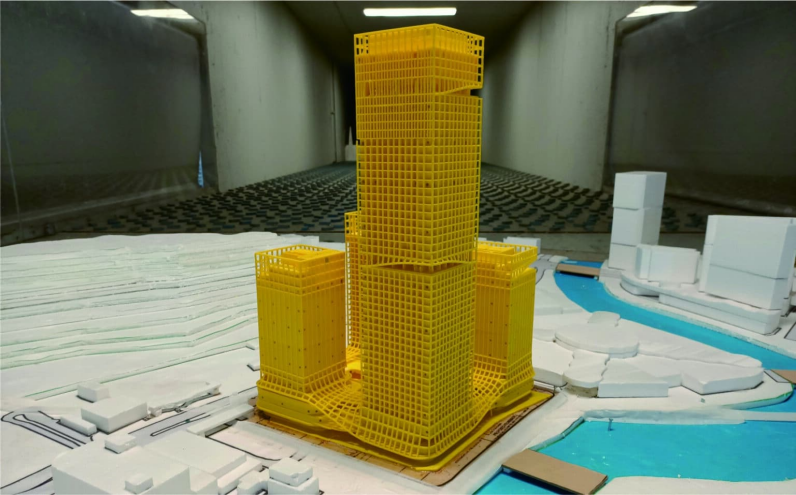
Figure 2: Wind tunnel test on buildings
2.3. Traffic loads
When the cars pass through irregular area, the loads would generate stress wave propagating in the soil, and affects the foundations of the adjacent buildings. The loads are normally caused by heavy trucks or buses instead of light cars[6]. The frequency and vibration level depend on many factors, such as the speed and weight of the vehicle, the roughness of road. the rougher the road, the more speed affects the vibration amplitude[7]. The traffic loads may lead to cracks on the elements of the structure or even building malfunctions and collapses. On the other hand, the long-term noise and vibration will affect people around.
3. Vibration analysis technique
There are several variables to evaluate structure dynamics and vibrations that have multiple degrees of freedom. To formulate the equation of motion in structure dynamics, multiple forces have to be applied to reach equilibrium conditions—applied load ( \( {p_{i}}(t)) \) , inertia \( { (f_{Ii}}) \) , damping force \( ({f_{Di}}) \) , and elastic force \( ({f_{Si}}) \) . Thus, the formula of in the equilibrium can be written as:
\( {f_{I}}+{f_{D}}+{f_{S}}=p(t) \)
Each of the forces here can be written in a more specific way, which means that each of them contains a coefficient:
\( { f_{Ii}}={ m_{ij}}{\ddot{v}_{j}} \)
where \( { m_{ij}} \) are the mass coefficients;
\( { f_{Di}}={ c_{ij}}{\dot{v}_{j}} \)
where \( { c_{ij}} \) are the damping coefficients;
\( { f_{Si}}={ k_{ij}}{v_{j}} \)
where \( { k_{ij}} \) are the stiffness coefficients.
After knowing the basic equilibrium in structure dynamics, two types of vibration will be analyzed: undamped free vibrations and damped free vibrations. The undamped free vibrations turn out to be simple since they only contain two coefficients—the mass coefficient and the stiffness coefficient. For some of the issues, modal superposition method would be applied, which means that orthogonality has been used, and the formula turns out to be:
\( v=ϕY=ϕ_{n}^{T}m \)
And \( {Y_{n}} \) , the nth normal coordinate can be written as:
\( {Y_{n}}(0)=\frac{ϕ_{n}^{T}mv(0)}{{M_{n}}} \)
The damped free vibration is not harder than the undamped one, since only one more coefficient has been added, that is the damped coefficient. There exist two types of damping: the Rayleigh damping and the Caughey damping, where the Rayleigh damping is:
\( c={a_{0}}m+{a_{1}}k \)
And Caughey damping is:
\( c=m\sum _{b}{{a_{b}}[{m^{-1}}k]^{b}} \)
The way to solve such an issue is also to go with orthogonality, which means \( ϕ \) has to be involved.
The only difference between the damped and undamped vibrations is that one variable has been added to the damped vibration. Otherwise, they are almost the same. Way of analyzing multiple degrees of freedom in structure dynamics are the formulas written above.
4. Vibration reduction control strategy
4.1. Passive vibration control technology
Passive vibration control technologies are widely known for their reliability and low maintenance requirements, making them a preferred choice in many civil engineering applications. Base isolation systems are one of the most effective passive methods to protect structures from seismic activities. These systems typically involve placing flexible holds between the foundation of the building and the superstructure, allowing the building to move independently of the movement of the ground.

Figure 3: Los Angeles city hall
A classic example is the regulation of San Francisco City Hall in figure3, where the placement of high-elastic rubber holders has significantly increased the building's earthquake resilience. The use of basic isolation was also essential in the delivery of Los Angeles City Hall, which was renovated in the 1990s to deal with severe earthquakes. [8]
Dampers are another key element of passive control systems, designed to break down vibrational energy through different mechanisms. For example, tuned mass dampers (TMDs), which are widely used in tall buildings and long-span bridges, work by shifting the structure frequency away from its natural frequency, thus reducing resonance.[9]
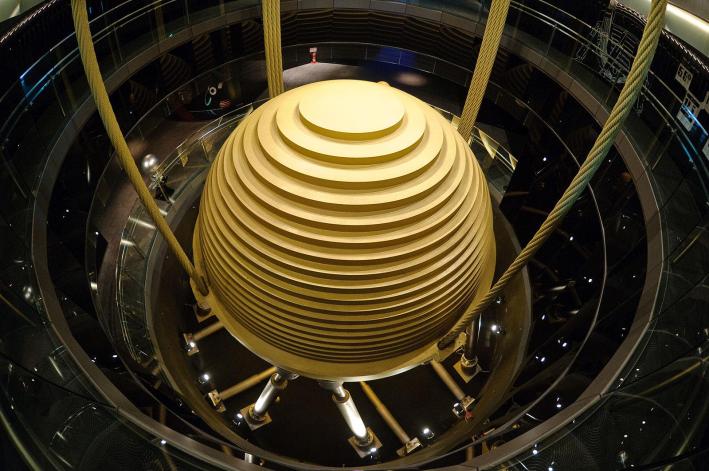
Figure 4: Taipei 101 TMD
As shown in figure 4, the Taipei 101 Tower in Taiwan is equipped with a 660-ton TMD that effectively reduces building sway during typhoons and earthquakes. Another example is The Millennium Bridge in London, where TMDs were deployed to dampen pedestrian-induced vibes after the bridge displayed excessive side movement during its opening.
4.2. Active vibration control technology
Active vibration control techniques provide a dynamic approach to managing structural vibrations by applying opposite forces in real time. These systems rely heavily on advanced sensor networks, computer algorithms and motors that can respond to detected vibrations almost instantaneously. The living comfort of high-rise buildings will be reduced due to wind induced vibrations, so most high-rise buildings will use active control[10].For example, a city company in New York City suspends 410 tons of concrete on hydraulic actuators as active, adjustable dampers that automatically adjust their position to counteract wind and stabilize the structure.

Figure 5: Denmark’s great belt bridge
Another example,The Danish Grand Belt Bridge in Figure 5 is one of the longest suspension bridges in the world.To manage the damage caused by wind vibrations to bridge,uses sensors placed along the bridge's surface to monitor vibrations, which are then encountered by motors that apply precise forces of motion restriction.This is also active vibration control techniques.
4.3. Semi-active vibration control technology
Semi-active control systems are a hybrid approach that combines the reliability of passive systems with the adaptability of active systems. These systems are particularly advantageous in scenarios where full active control is not feasible due to power constraints or the need for high reliability. “Magnetorheological (MR) dampers” are a widely used semi-active technology. These dampers contain a fluid whose viscosity can be rapidly altered by applying a magnetic field, allowing for real-time adjustments in damping characteristics. The “Dongting Lake Bridge” in China employs MR dampers to adapt to varying traffic loads and seismic events, enhancing the bridge’s resilience and extending its lifespan.
This is a manifestation of the application of semi-active control in high-rise buildings, where “variable stiffness systems” are used to adjust the building’s natural frequency in response to external forces. For example, the “Shinjuku Park Tower” in Tokyo features a semi-active vibration control system that adjusts the stiffness of the structure depending on the intensity and direction of wind loads. This capability allows the building to remain stable and comfortable for occupants even during strong wind events, without the need for large-scale active control systems[11].
4.4. Application of smart materials in vibration control
Intelligent materials provide breakthrough possibilities in vibration control due to their ability to autonomously respond to environmental changes. Shape Memory Alloys (SMA) is one of the most extensively researched smart materials for structural applications. These alloys can “remember” their original shape and return to it after deformation when exposed to certain stimuli, such as temperature changes. In seismic engineering, SMAs have been used in the retrofitting of bridges and buildings to enhance their energy dissipation capabilities. For instance, SMAs were incorporated into the “Gabbia Bridge” in Italy, where they provided additional damping and restored the structure to its original alignment after seismic events.
Piezoelectric materials also have significant potential in vibration control. These materials generate an electric charge in response to mechanical stress and can also deform when an electric field is applied. In aerospace engineering, piezoelectric actuators are used in the active control of aircraft wings to suppress aeroelastic vibrations.
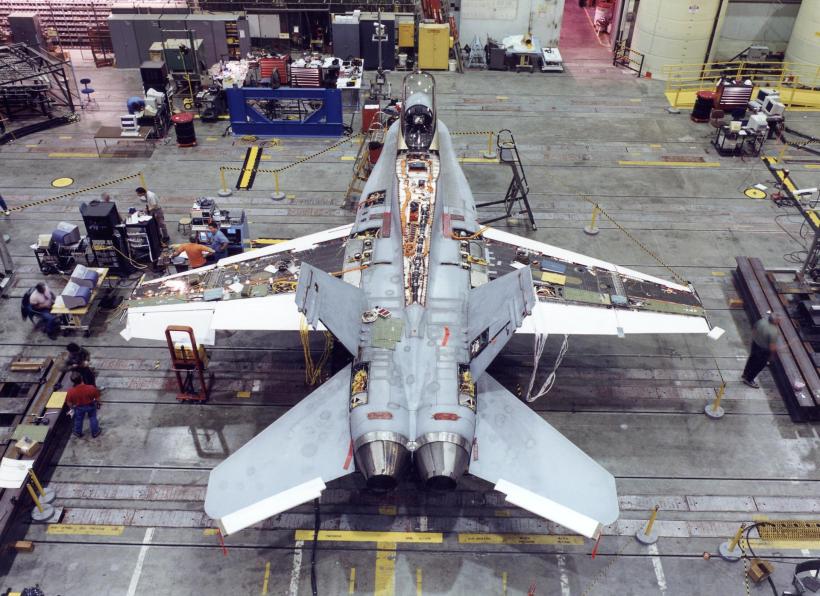
Figure 6: X-53
For example, the “X-53 Active Aeroelastic Wing” illustrated in figure6, program by NASA demonstrated the use of piezoelectric actuators to actively control wing shape and reduce vibrations during flight, leading to improved aerodynamic performance and structural longevity[12].
5. Case studies
Figure7 shows Taipei 101, is one of the tallest skyscrapers in the world and is located in earthquake-prone Taiwan. To counteract vibrations caused by strong winds and earthquakes, Taipei 101 was fitted with a giant 660-ton Tuned Mass Damper. Suspended between the 88th and 92nd floors of the building, this Tuned Mass Damper counteracts wind and earthquake-induced vibrations by swaying. This Tuned Mass Damper not only improve wind and seismic performance of the building, but also enhanced safety and comfort of the building, stabilizes the building in extreme conditions[13].

Figure 7: Taipei 101
Besides, in Federal Reserve Bank of Boston, which shows in figure8, higher floors will be exposed to severe tremors. The building utilizes a combination of tuned mass dampers and passive damping systems that control the building's oscillations by reducing the structural response. Finally, it will enhances the comfort of the living and working environment.
These success stories show how modern buildings can meet the challenges posed by natural and man-made factors through vibration control technology. Through proper selection and installation of vibration control systems, buildings can not only withstand natural disasters such as earthquakes and wind, but also enhance comfort and longevity. The successful implementation of these projects provides valuable experience and reference for future building design.
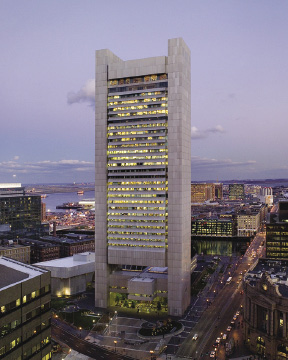
Figure 8: Federal reserve bank of boston
However, there are some failures. First of all, the Hokkaido International Building shows in figure9 is a high-rise building in Hokkaido, Japan, located in an earthquake-prone area. The building relied excessively on tuned mass dampers in its design, but failed to give due consideration to the special local seismic wave characteristics. During an actual earthquake, the frequency of the seismic waves did not match the tuning frequency of the TMDs, resulting in ineffective functioning of the TMDs. In addition, the foundation structure of the building was not strong enough to provide sufficient rigidity to cope with earthquakes. The lesson learned from this example is,in the design of vibration control, due consideration must be given to the seismic wave characteristics of the area to ensure that the frequency of the vibration control device matches the characteristic frequency of the potential hazard. At the same time, the design of the foundation structure must be coordinated with the vibration control system to provide adequate support and stiffness[14].
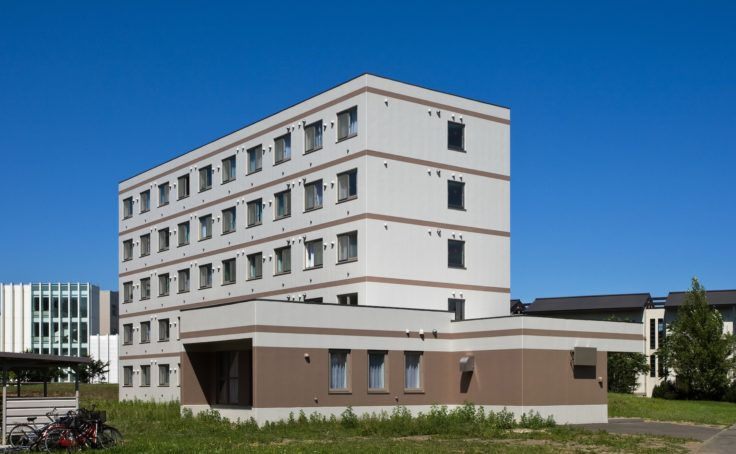
Figure 9: Hokkaido international building
Moreover, figure10 shows London’s Millennium Bridge which is a famous suspension pedestrian bridge connecting St. Paul's Cathedral and the Tate Modern. However, on the first weekend after its opening in 2000, the bridge experienced severe lateral vibrations, causing anxiety for pedestrians and forcing it to close for repairs[15]. The reason for the failure was the design fails to anticipate the potential for resonance caused by a large number of pedestrians walking in synchronization. So when designing a footbridge, it is important to consider possible dynamic loads and their effects on the structure, especially in the resonant frequency range. Last but not least, adequate dynamic analysis should be carried out prior to design in order to assess the various possible vibration scenarios.
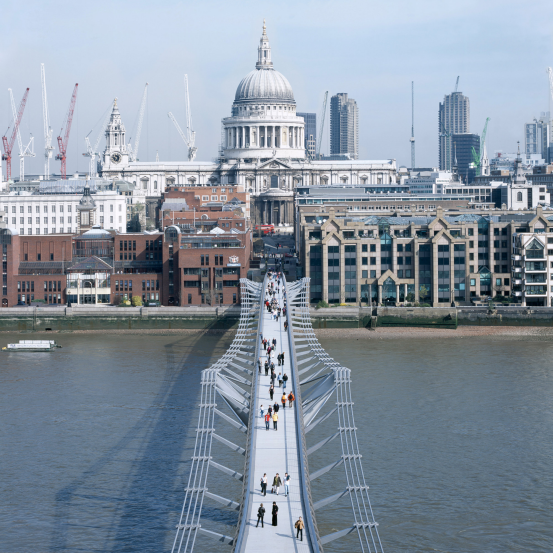
Figure 10: London's millennium bridge
6. Research trends and future development
In recent years, with the improvement of computing power and the advancement of materials science, the research of building vibration has shown the following trends and future development directions:
Computer simulation and numerical analysis: With the development of computer technology, numerical simulation plays an increasingly important role in the study of building vibration. Techniques such as finite element analysis (FEA) and multi-body dynamics simulation (MBD) are widely used to predict the response of buildings under various loads. The continuous improvement of these techniques makes the simulation results more accurate and provides a reliable basis for the design of safer and more economical structures.
Materials Science and Smart materials: Applications of smart materials such as shape memory alloys (SMA) and piezoelectric materials are gaining increasing attention in building vibration control. These materials can self-adjust in response to environmental changes, thus enhancing the adaptability and seismic performance of the structure. In addition, the development of composite materials has also opened up a new situation for the application of lightweight and high-strength building materials.
Vibration control technology: passive control, active control and semi-active control technology have been widely used in building vibration control. Active mass dampers (ATMD), magnetorheological dampers (MRD) and active control strategies based on feedback systems are becoming research hotspots. These technological advances have greatly improved the stability and safety of buildings under extreme conditions.
Monitoring technology and data analysis: The development of sensor technology makes it possible to monitor buildings in real time. Through the Internet of Things (IoT) and big data analytics, the health of buildings can be assessed in real time, potential structural problems can be predicted, and preventive measures can be taken before problems occur[16].
7. Conclusion
In this paper, the main content of building vibration research is reviewed, especially vibration under different loads. Through the literature review, the following important conclusions are found:
Vibration prediction and control under multiple loads: Different types of loads, such as earthquakes, wind and traffic, have significantly different effects on buildings. Therefore, it is necessary to carry out special vibration analysis and control measures for different load conditions.
Application prospect of new technology: With the improvement of computing power and the development of new materials, the construction vibration control technology has been significantly improved. The application of these technologies not only improves the safety and reliability of buildings, but also reduces the construction cost.
Continuous monitoring and maintenance: Continuous monitoring and maintenance of buildings is an important means to ensure their long-term stability. Modern sensors and monitoring technologies make this process more efficient and accurate.
Acknowledgement
Yuanhan Gao, Zhuboyan Guo, Yifan Li, Tingxuan Mao, Xinyi Wu and Haoxian Zeng contributed equally to this work and should be considered co-first authors.
References
[1]. Naeim, F., & Kelly, J. M. (1999). Design of Seismic Isolated Structures: From Theory to Practice. John Wiley & Sons.
[2]. Qiu, Yanjia, er al. Analysis of earthquake response mechanism of subway stations adjacent to ground buildings, Proceedings of the Academic Conference on Foundation Foundation of China Architectural Society, (2022) 2023.
[3]. Mele, E. , A. D. Luca , and A. Giordano . Modelling and analysis of a basilica under earthquake loading. Journal of Cultural Heritage, 4.4(2003):355-367.
[4]. Mendis, Priyan, et al. Wind loading on tall buildings. Electronic Journal of Structural Engineering Volume, 7.2007(2007):41-54.
[5]. “Wind Tunnel Test on Buildings”. windtechconsult.com, windtechconsult.com/advantages-of-wind-tunnel-testing-on-buildings/
[6]. Traffic Vibrations in Buildings by Osama Hunaidi, (2000).
[7]. Jakubczyk-Galczynska, Anna , and R. Jankowski . Traffic-induced vibrations. The impact on buildings and people, (2014).
[8]. “Los Angeles City Hall.” Wikipedia, 21 Apr. 2020, en.wikipedia.org/wiki/Los_Angeles_City_Hall.
[9]. Spencer, B. F., & Nagarajaiah, S. (2003). State of the Art of Structural Control. Journal of Structural Engineering, 129(7), 845-856.
[10]. Soong, T. T., & Spencer, B. F. (2002). Active, Hybrid, and Semi-Active Structural Control: A Design and Implementation Handbook. John Wiley & Sons.
[11]. Dyke, S. J., & Spencer, B. F. (1997). A Comparison of Semi-Active Control Strategies for the MR Damper. Proceedings of the American Control Conference, 1600-1605.
[12]. “EC01-0076-1 - NASA.” NASA, NASA, 2024, www.nasa.gov/image-detail/amf-ec01-0076-1/. Accessed 20 Aug. 2024.
[13]. Chen, H. C., Loh, C. H., & Yang, Y. S. (2008). Seismic Performance of the Taipei 101 Tower: A Nonlinear Time-Domain Analysis. Journal of Structural Engineering, 134(11), 1634-1645.
[14]. Dolce, M., Cardone, D., & Ponzo, F. C. (2001). Shaking Table Tests on Reinforced Concrete Frames with Different Isolation Systems. Journal of Earthquake Engineering, 5(4), 535-563.
[15]. “Great Belt Bridge - Facts and History of Great Belt Fixed Link.” Www.bridgesdb.com, www.bridgesdb.com/bridge-list/great-belt-bridge/.
[16]. Housner, G. W., & Bergman, L. A. (1997). Structural Control: Past, Present, and Future. Journal of Engineering Mechanics, 123(9), 897-971.
Cite this article
Gao,Y.;Guo,Z.;Li,Y.;Mao,T.;Wu,X.;Zeng,H. (2025). Structural Dynamics and Vibration with Multiple Degree of Freedom under Different Types of Loads. Theoretical and Natural Science,107,270-279.
Data availability
The datasets used and/or analyzed during the current study will be available from the authors upon reasonable request.
Disclaimer/Publisher's Note
The statements, opinions and data contained in all publications are solely those of the individual author(s) and contributor(s) and not of EWA Publishing and/or the editor(s). EWA Publishing and/or the editor(s) disclaim responsibility for any injury to people or property resulting from any ideas, methods, instructions or products referred to in the content.
About volume
Volume title: Proceedings of the 4th International Conference on Computing Innovation and Applied Physics
© 2024 by the author(s). Licensee EWA Publishing, Oxford, UK. This article is an open access article distributed under the terms and
conditions of the Creative Commons Attribution (CC BY) license. Authors who
publish this series agree to the following terms:
1. Authors retain copyright and grant the series right of first publication with the work simultaneously licensed under a Creative Commons
Attribution License that allows others to share the work with an acknowledgment of the work's authorship and initial publication in this
series.
2. Authors are able to enter into separate, additional contractual arrangements for the non-exclusive distribution of the series's published
version of the work (e.g., post it to an institutional repository or publish it in a book), with an acknowledgment of its initial
publication in this series.
3. Authors are permitted and encouraged to post their work online (e.g., in institutional repositories or on their website) prior to and
during the submission process, as it can lead to productive exchanges, as well as earlier and greater citation of published work (See
Open access policy for details).
References
[1]. Naeim, F., & Kelly, J. M. (1999). Design of Seismic Isolated Structures: From Theory to Practice. John Wiley & Sons.
[2]. Qiu, Yanjia, er al. Analysis of earthquake response mechanism of subway stations adjacent to ground buildings, Proceedings of the Academic Conference on Foundation Foundation of China Architectural Society, (2022) 2023.
[3]. Mele, E. , A. D. Luca , and A. Giordano . Modelling and analysis of a basilica under earthquake loading. Journal of Cultural Heritage, 4.4(2003):355-367.
[4]. Mendis, Priyan, et al. Wind loading on tall buildings. Electronic Journal of Structural Engineering Volume, 7.2007(2007):41-54.
[5]. “Wind Tunnel Test on Buildings”. windtechconsult.com, windtechconsult.com/advantages-of-wind-tunnel-testing-on-buildings/
[6]. Traffic Vibrations in Buildings by Osama Hunaidi, (2000).
[7]. Jakubczyk-Galczynska, Anna , and R. Jankowski . Traffic-induced vibrations. The impact on buildings and people, (2014).
[8]. “Los Angeles City Hall.” Wikipedia, 21 Apr. 2020, en.wikipedia.org/wiki/Los_Angeles_City_Hall.
[9]. Spencer, B. F., & Nagarajaiah, S. (2003). State of the Art of Structural Control. Journal of Structural Engineering, 129(7), 845-856.
[10]. Soong, T. T., & Spencer, B. F. (2002). Active, Hybrid, and Semi-Active Structural Control: A Design and Implementation Handbook. John Wiley & Sons.
[11]. Dyke, S. J., & Spencer, B. F. (1997). A Comparison of Semi-Active Control Strategies for the MR Damper. Proceedings of the American Control Conference, 1600-1605.
[12]. “EC01-0076-1 - NASA.” NASA, NASA, 2024, www.nasa.gov/image-detail/amf-ec01-0076-1/. Accessed 20 Aug. 2024.
[13]. Chen, H. C., Loh, C. H., & Yang, Y. S. (2008). Seismic Performance of the Taipei 101 Tower: A Nonlinear Time-Domain Analysis. Journal of Structural Engineering, 134(11), 1634-1645.
[14]. Dolce, M., Cardone, D., & Ponzo, F. C. (2001). Shaking Table Tests on Reinforced Concrete Frames with Different Isolation Systems. Journal of Earthquake Engineering, 5(4), 535-563.
[15]. “Great Belt Bridge - Facts and History of Great Belt Fixed Link.” Www.bridgesdb.com, www.bridgesdb.com/bridge-list/great-belt-bridge/.
[16]. Housner, G. W., & Bergman, L. A. (1997). Structural Control: Past, Present, and Future. Journal of Engineering Mechanics, 123(9), 897-971.









